Are Homeowners Still Eyeing Up The Countryside?
Back in 2020, we published this post exploring the sudden spike in homeowners looking to move away from urban areas to the countryside.
The three consecutive lockdowns through 2020,2021 and 2022 was a considerable driving force behind the interest in country living. But is that demand still there now that 'normal life' has somewhat resumed?
Do people still long for more garden space, fresh air and escaping from the hustle and bustle of city life nearly three years after the shock of a global pandemic? Or are people having second thoughts about moving away from areas that provide easy access to an array of shops, restaurants and entertainment facilities?
We examined our data...
How the pandemic altered our lifestyles in the long term
Amidst the global pandemic, the news was full of how COVID had changed the way people approach their day-to-day life and still live these new 'lifestyles' today. Some of the most common themes included:
1) Swapping the workplace for remote working in the long term
Just shy of 50% of working adults had to work from their homes throughout the pandemic. When lockdowns were lifted and people were encouraged to resume their daily commute to their workplaces, many didn't want to simply go back to business as usual.
In an Opinions and Lifestyle Survey carried out by the ONS, more than eight in ten adults who had worked from home opted for the hybrid model of working over going back to their workplaces full time.
And this trend is only increasing, with hybrid working increasing from 13% in February 2022 to 24% in May 2022.
2) Spending time outdoors is still important to people - even after lockdown
The nature of lockdown rules and health concerns meant that many people took to outdoor socialising much more in 2020 compared to previously. And that desire to be in open, rural areas hasn't gone away.
The People and Nature Survey reflected that almost half of adults (45%) are spending more time outside than they did pre-pandemic. And 39% specified that wildlife and nature were 'more important than ever' to their well-being.
The pandemic also highlighted 'green inequality' in England too, showing that cities and towns had too little green spaces, trees, and rivers compared to rural areas. The air quality is also worse.
3) Selling urban homes and purchasing rural homes
In our previous article published in 2020, we highlighted the many benefits that were enticing people to buy a new home and move to the country. These included a higher life expectancy for rural residents and better air quality.
But are people still yearning for country living, and if so, what rural areas have the highest demand?
Are more people still moving to rural areas?
At TwentyCi, we have built and maintained the UK's largest and most sophisticated homemover database. We dove into our data to see if the allure of rural living was still strong. Here's what we found:
Property transactions for 'country homes' has actually dropped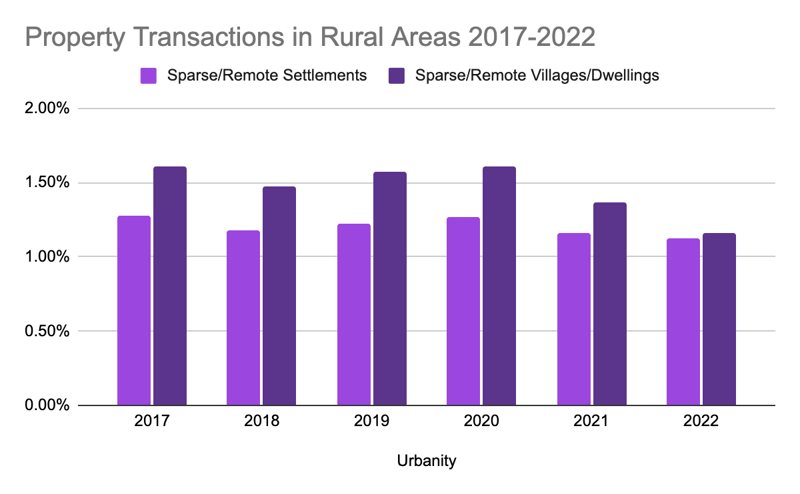
Feel free to use these graphs on your own site but please link back to this page.
Our data shows that from 2017 to 2022, the number of people looking to move to sparse or remote settlements actually decreased by 13%
Similarly, people moving to sparse, remote villages or dwellings dropped by 28%%
Meanwhile, the number of people purchasing properties in smaller urban areas in 2022 increased by 0.84% compared to 2017:
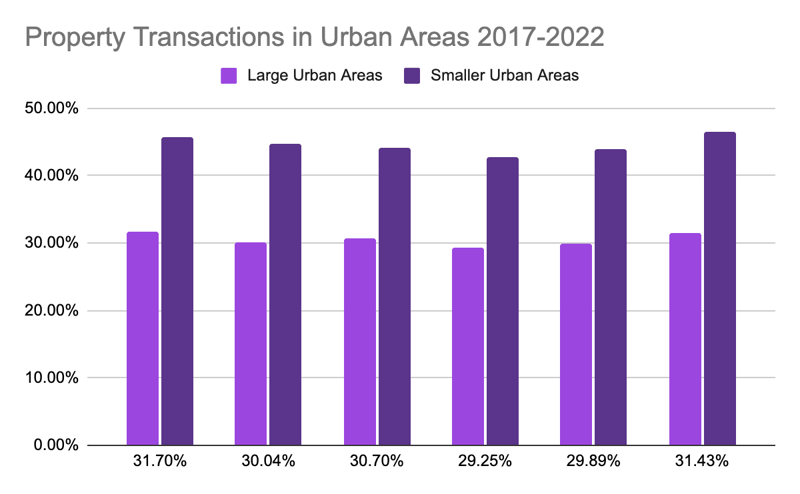
Feel free to use these graphs on your own site but please link back to this page.
What does this tell us?
While you could draw the conclusion here that the lure of fresh air, open space and beautiful scenery never really spiked throughout the pandemic and afterwards, especially compared to city areas, this data only really gives us a little glance at the story. Nick, our Commercial Director explains more:
"While property exchanges are a great metric to track, it is only the first step to understanding whether people are still eager to move to the countryside. While it shows us how many properties are being sold, it doesn't demonstrate underlying aspirational demand.
If countryside dwellers don't want to sell their properties, there will be less available on the property market and, therefore, instructions sold subject to contract (SSC) and completions will be lower.
What this data does show us is that people were still looking to move out of their urban homes.”
Which regions are more popular post-pandemic?
Considering that the entire UK on average has seen an increase in property movement compared to the pre-pandemic era (11.4%), which regions were the most, and least, popular?
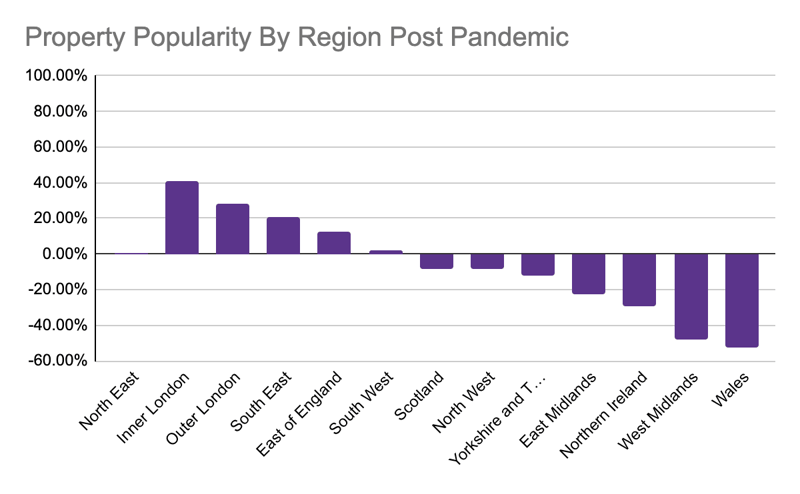 Feel free to use these graphs on your own site but please link back to this page.
Feel free to use these graphs on your own site but please link back to this page.
With the amount of news coverage surrounding the desire to move to the countryside that was seen throughout the pandemic, you wouldn't expect the North East, Inner and Outer London and the South East to be outperforming the likes of Wales.
What does this tell us?
Once again, this seemingly rejects the theory of the countryside growing in popularity. Until you compare it to average house price increases in the year to November 2022.
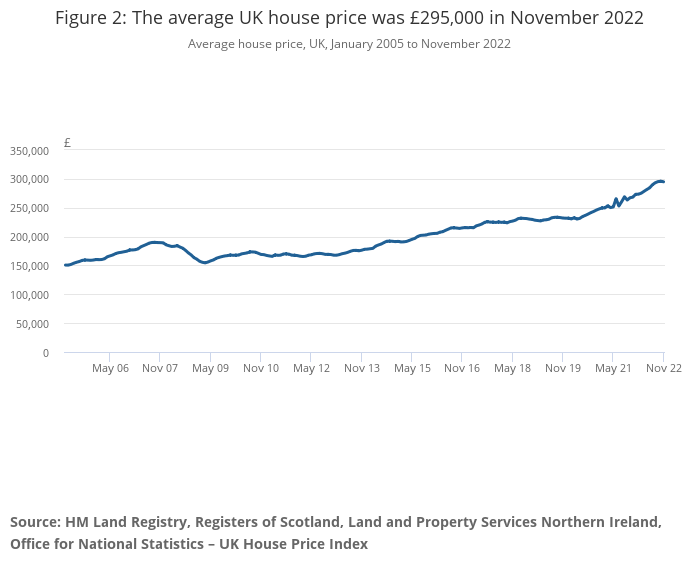
As you can see from the above graph from the Office of National Statistics, average house prices were already on the rise before COVID hit the UK's doorstep.
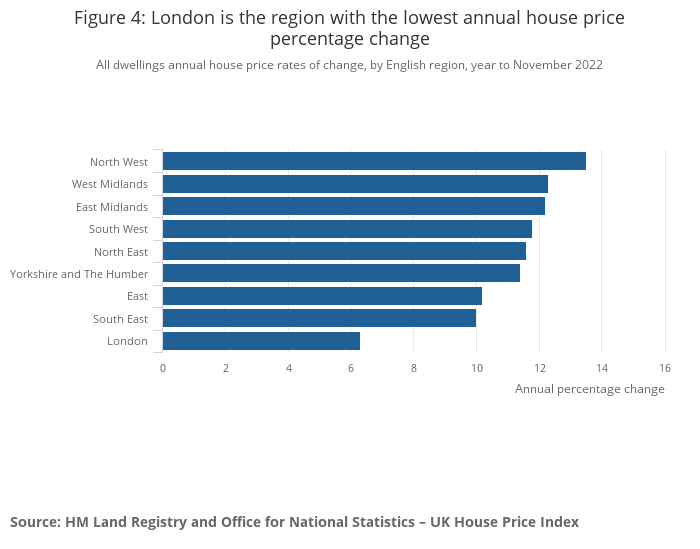
When you whittle this down by region, you see that England, London and the South East have seen the lowest annual price change. The more rural areas are seeing a greater difference in annual house price percentage change.
Again, property transactions are only telling us part of the story. More properties are being purchased in urban areas, but that could be heavily influenced by the rise in house prices in the more desirable regions - essentially pricing people out of the market.
If you'd like to stay up to date on average property prices per month, sign up for our newsletter to get our monthly Pulse straight to your inbox.
Which regions have become more expensive?
We touched on property price above, and this is a great measurement of how desirable an area is and how much interest there is from buyers. Effectively, the higher the average property price, the greater the demand.
So, we dove back into our data to look at the Compound Annual Growth Rate in the UK by region. Average property prices have increased by 6.8% per annum throughout the UK, so what can our data tell us about desirability within these regions?
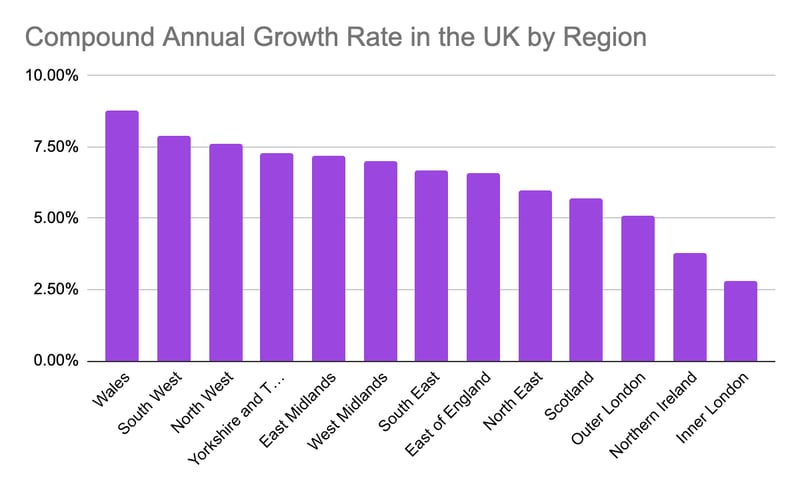
Feel free to use these graphs on your own site but please link back to this page.
This first graph shows us the annual increase in property prices in 2022 per region compared to pre-pandemic levels.
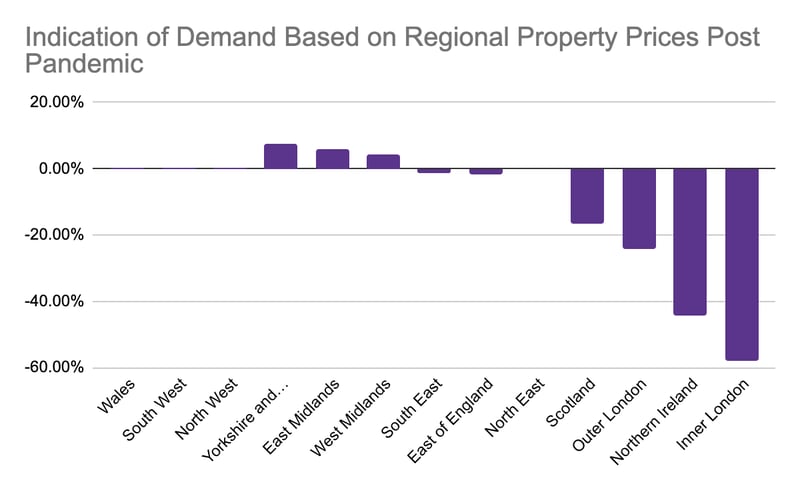
Feel free to use these graphs on your own site but please link back to this page.
This second graph covers the same areas but shows whether they performed better or worse than the national average increase. Regions that have seen positive growth show a greater demand.
When we look at the data in this way, we get a much better picture of where UK adults actually want to live in a post-pandemic world.
So far, this proves that while there is less activity in Wales, the South West and North West, Yorkshire and The Humber, the East Midlands, and the West Midlands, in regard to transactions, when you consider demand, they currently come out as the winners.
However, to get the ultimate picture of which areas are the highest in demand post-pandemic, we need to dig even deeper.
Which regions have the quickest time to sell?
Time to sell is another fantastic indicator of demand. The quicker these properties get snapped up, the more desirable that region is.
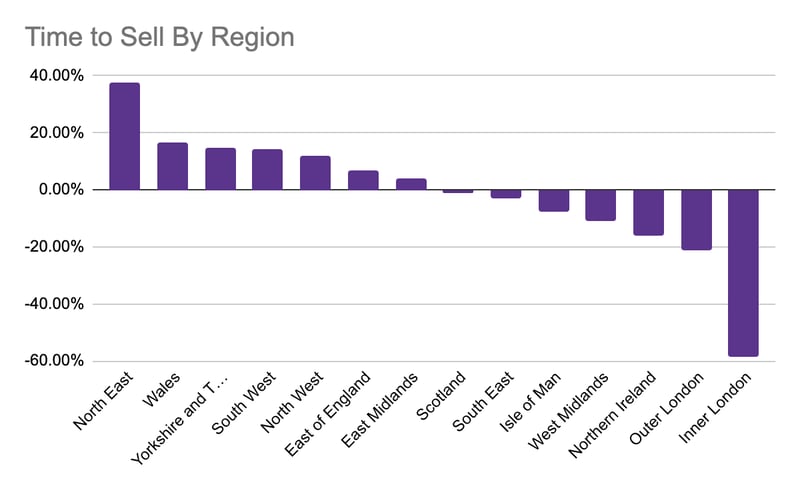
Feel free to use these graphs on your own site but please link back to this page.
The above graph highlights which regions are more attractive post-pandemic based on how long it takes to buy and sell properties. Using this as a measurement metric, the most sought-after properties are located in the North East, Wales and Yorkshire and The Humber.
The regions that are the least attractive post-pandemic based on time to sell are Inner London, Northern Ireland and Outer London.
So, what is the most desirable UK region post-COVID?
Almost a year since the last lockdown ended, and three years after the news began circulating stories about UK adults wanting to move to more rural environments, which region is the most sought after, and is the desire for countryside life still there?
Nick gives us the results based on an amalgamation of all our data:
"Our data shows that Wales is the most desirable UK region - proved by property prices increasing by 8.8%, 29.5% more than the UK average. The time it takes to sell property in Wales has fallen by 45.3%, 16.6% better than the rest of the UK."
The runner-up was the South West, with:
- A property price increase of 7.9%, 16.3% better than the UK
- A time to sell of -44.2%, 14.1% faster than the rest of the UK
Third place was taken by the North East, with:
- A property price increase of 6%, 11.6% better than the UK
- A time to sell of -53.4%, 37.6% faster than the rest of the UK
All of these regions are largely rural, so it's safe to say the demand to move away from urban areas is still strong.
What are the most desirable postcodes?
We've used our data to ascertain the most sought-after postcodes. Here are the top 15:
- Shetland
- Carlisle
- Swansea
- Kilmarnock
- Galashiels
- Llandudno
- Truro
- Shrewsbury
- Torquay
- Kirkaldy
- Plymouth
- Exeter
- Lancaster
- Wakefield
- Hereford
While there will always be demand for property in urban environments, the trend to move to more rural areas is still strong.
How can this data help retailers?
Homeowners remain the most economically valuable consumer group. Our Property and Homemover Report End of Year Summary states that the housing market will continue to be pivotal to the UK economy - providing fantastic opportunities for retailers to connect with consumers and play a part in such an important milestone in their customers' lives.
Last year alone there was £29 billion worth of sales transactions as a result of house moves. But the key to success will be knowing who to target, and when, to increase your marketing return on investment. The kinds of home-related products home movers are searching for and buying will change as they progress through the buying journey. Here's an example of what opportunities were available for home retailers in October 2022 alone.
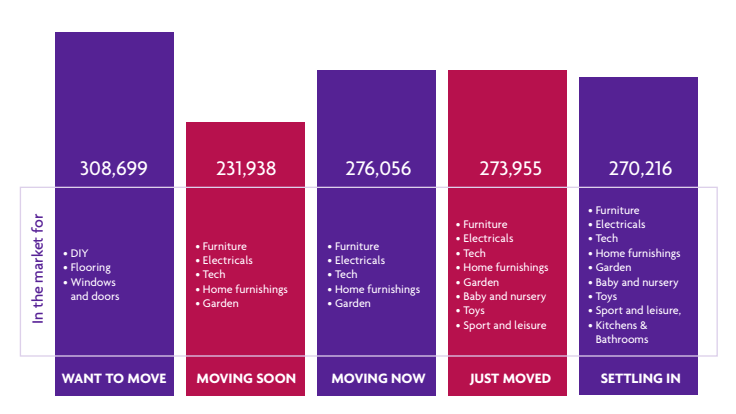
We can provide you with up-to-date information on what is influencing your target market and how you can increase your chances of selling to them. Just as we've shown above, we can help you tease out valuable insights from our data that will make a tangible difference to your bottom line.
[Find out more about our Homemover Data]
Leave a comment
